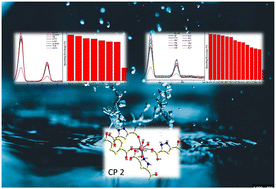Two lanthanoid-carboxylate directed coordination polymers for the luminescent selective detection of Fe3+ and meta-nitroaniline in aqueous solution†
Abstract
In recent years, due to their tunable hierarchical architecture and wide versatility in applications, the synthesis of coordination polymers (CPs) has received wide attention from the scientific community. The present work focuses on the solvothermal synthesis of two novel lanthanoid CPs composed of gadolinium and dysprosium connected with 1H-pyrazole-3,5-dicarboxylic acid (1H-3,5-PDA) and benzene-1,4-dicarboxylic acid (1,4-BDC) linkers. The prepared materials were assessed using elemental analysis, SCXRD, FTIR, PXRD, thermogravimetric analysis and photoluminescence. The synthesized sensor (CP 2) is an efficient chemosensor for the detection of Fe3+ and meta-nitro aniline, thereby acting as a dual sensor. The material exhibits high quenching efficiencies of 98.25% and 98.11% towards the sensing at ppm-level concentrations of Fe3+ and m-NA, respectively. The Ksv values for the detection of Fe3+ and m-NA were found to be 3.76 × 104 L mol−1 and 2.5 × 104 L mol−1, respectively, which the confirm high and efficient sensing ability of the synthesized sensor.



 Please wait while we load your content...
Please wait while we load your content...